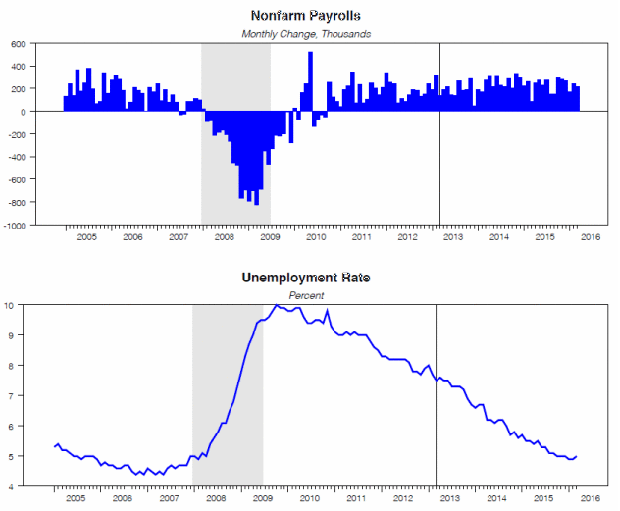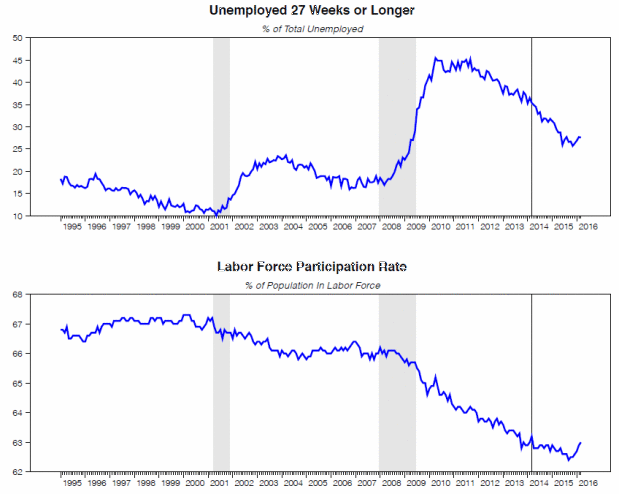What Janet Yellen sees on her job market "dashboard"
As the economy continues its slow but steady climb back to full employment, how worried should we be that another downturn will hit the before that journey is complete? At a National Bureau of Economic Research conference in Cambridge, Massachusetts, that I attended last week, Larry Summers said he believes the chance of another recession in the next three years is 50 percent. Should that be cause for alarm?
A good place to begin is Federal Reserve Chair Janet Yellen's labor market "dashboard" -- a set of employment indicators she watches for signs the economy is too hot, too cold or just right. These signals are suggesting the Fed should move cautiously in its desire to normalize interest rates as the economy enters a more mature stage of the expansion, but they do not raise concerns that recession is just around the corner.
The first two indicators are nonfarm payrolls and the unemployment rate (the shaded areas in the following nine charts are recessions, and the vertical line is when Yellen announced the components of her dashboard in a March 2013 speech):
Changes in nonfarm payrolls show a slight downward trend in recent months, and the unemployment rate has edged up a bit from 4.9 to 5 percent. However, the change in nonfarm payrolls remains large enough to absorb new entrants to the labor market and still create additional jobs, indicating that the rate of job creation remains healthy. But it's worth keeping an eye on this series to see if the downward trend continues.
The slight uptick in the unemployment rate was the result of new entrants to the labor market (people who left the labor force during the recession returning) rather than an increase in the number of people who've lost a job. This is a sign that people believe the chance of getting a job has increased, so there's no reason for concern.
Yellen also said she follows a broader measure of unemployment that includes discouraged workers and part-time workers who would like to work full time. But that series looks very much like the official unemployment rate in terms of how it has been changing recently, so it offers no additional information.
The next two series on the dashboard are the hiring rate and the quit rate:
The hiring rate has leveled off in recent months after a relatively steady increase, but the leveling off is likely due to the economy entering the mature stage of the expansion. If it begins to turn downward, that would signal trouble, but there's no sign of that happening at this point.
The quit rate has increased steadily since the recession's end, but that's a signal that people are more optimistic they can find another job. Workers tend to stay put when the economy is in recession, so this is indicates that workers believe the labor market is improving.
One sign of a strong labor market is rising wages, and as the second figure below shows, the rate of increase in wages has been generally trending upward in recent months, though the most recent data shows wages declining and then leveling off. If the labor market was tightening significantly, wages would be more likely to show even further increases rather than the leveling shown in the figure. So, wages don't appear to be in danger of producing significant inflationary pressure.
The other indicator, workers employed part-time for economic reasons, appears to be leveling off after a long period of decline. Once again, this is evidence that the economy is entering the mature stage of expansion, where the recovery period is ending and the economy is nearing, but not yet at, full employment.
Finally, the last two indicators are long-term unemployment and the labor force participation rate:
The labor force participation rate has finally turned around after a long period of decline, a very positive sign for labor markets. But long-term unemployment has leveled off at a high rate, much higher than it has been in the past. Thus, while labor markets have improved substantially since the end of the recession, some workers are having a very difficult time finding employment.
One indicator not on the dashboard that has raised concerns for some is temporary help services. This has blipped down recently, but this is most likely due to the end of the rapid expansion phase of the business cycle rather than a sign that a recession is ahead. Still, it's certainly something to keep an eye on in coming months and a reason for the Fed to move very cautiously at this juncture.
Overall, the Fed is likely to take the view that labor markets continue to show signs of improvement because the series are leveling off rather than turning downward. But there's no reason to rush the next increase in its target interest rate. If wages begin to increase rapidly and inflation rises above its target rate, the Fed will need to act, but for now these aren't problems.
My view is that the labor market still has room to expand without the Fed worrying about inflationary pressures, so a cautious approach is warranted. For now the economy isn't too hot. If anything, it remains a bit too cold with a chance of further cooling ahead. So, the Fed shouldn't turn down the heat unless and until the economy shows clear signs of boiling over.





